flat tire TOYOTA VERSO 2013 User Guide
[x] Cancel search | Manufacturer: TOYOTA, Model Year: 2013, Model line: VERSO, Model: TOYOTA VERSO 2013Pages: 616, PDF Size: 39.6 MB
Page 430 of 616
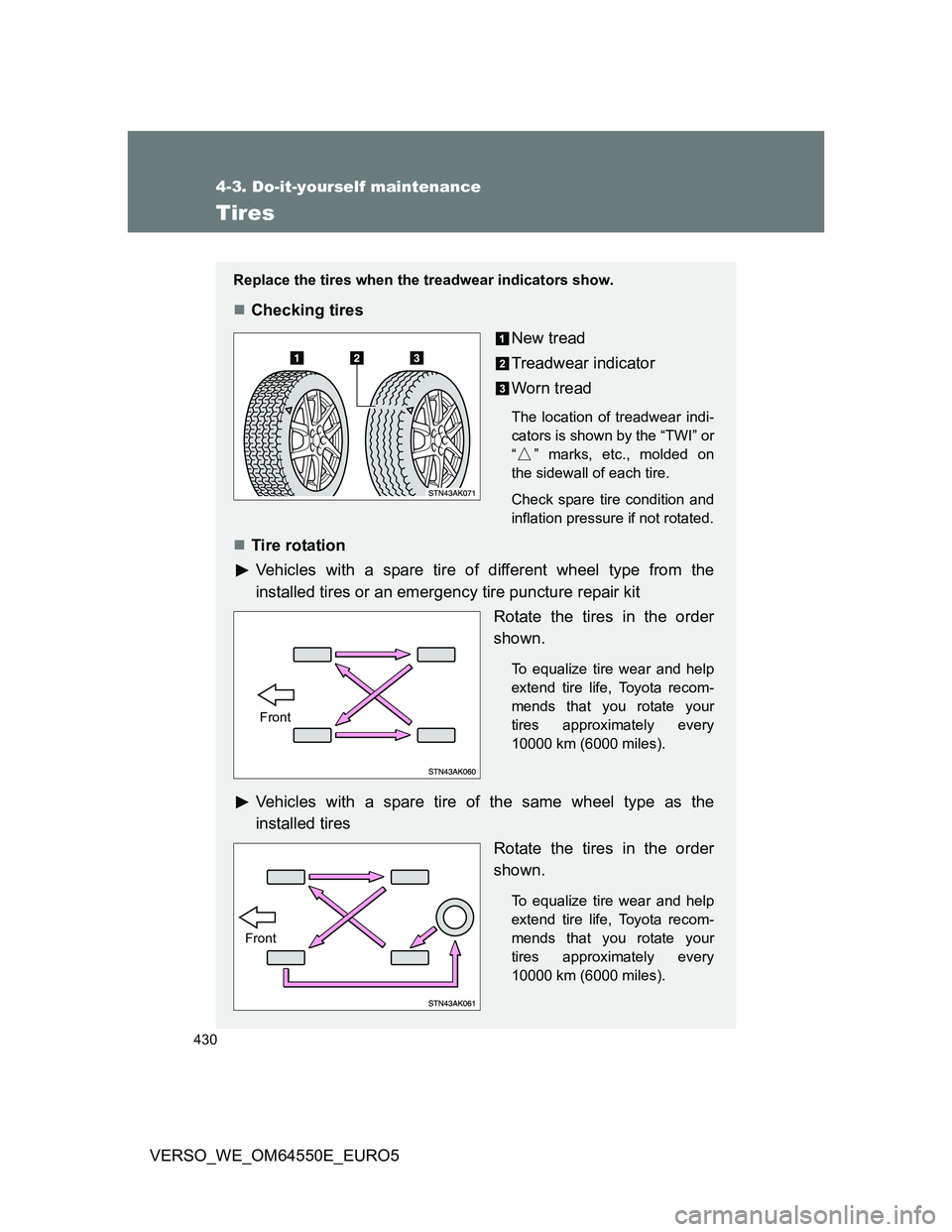
430
4-3. Do-it-yourself maintenance
VERSO_WE_OM64550E_EURO5
Tires
Replace the tires when the treadwear indicators show.
Checking tires
New tread
Treadwear indicator
Worn tread
The location of treadwear indi-
cators is shown by the “TWI” or
“ ” marks, etc., molded on
the sidewall of each tire.
Check spare tire condition and
inflation pressure if not rotated.
Tire rotation
Vehicles with a spare tire of different wheel type from the
installed tires or an emergency tire puncture repair kit
Rotate the tires in the order
shown.
To equalize tire wear and help
extend tire life, Toyota recom-
mends that you rotate your
tires approximately every
10000 km (6000 miles).
Vehicles with a spare tire of the same wheel type as the
installed tires
Rotate the tires in the order
shown.
To equalize tire wear and help
extend tire life, Toyota recom-
mends that you rotate your
tires approximately every
10000 km (6000 miles).
Front
Front
Page 431 of 616
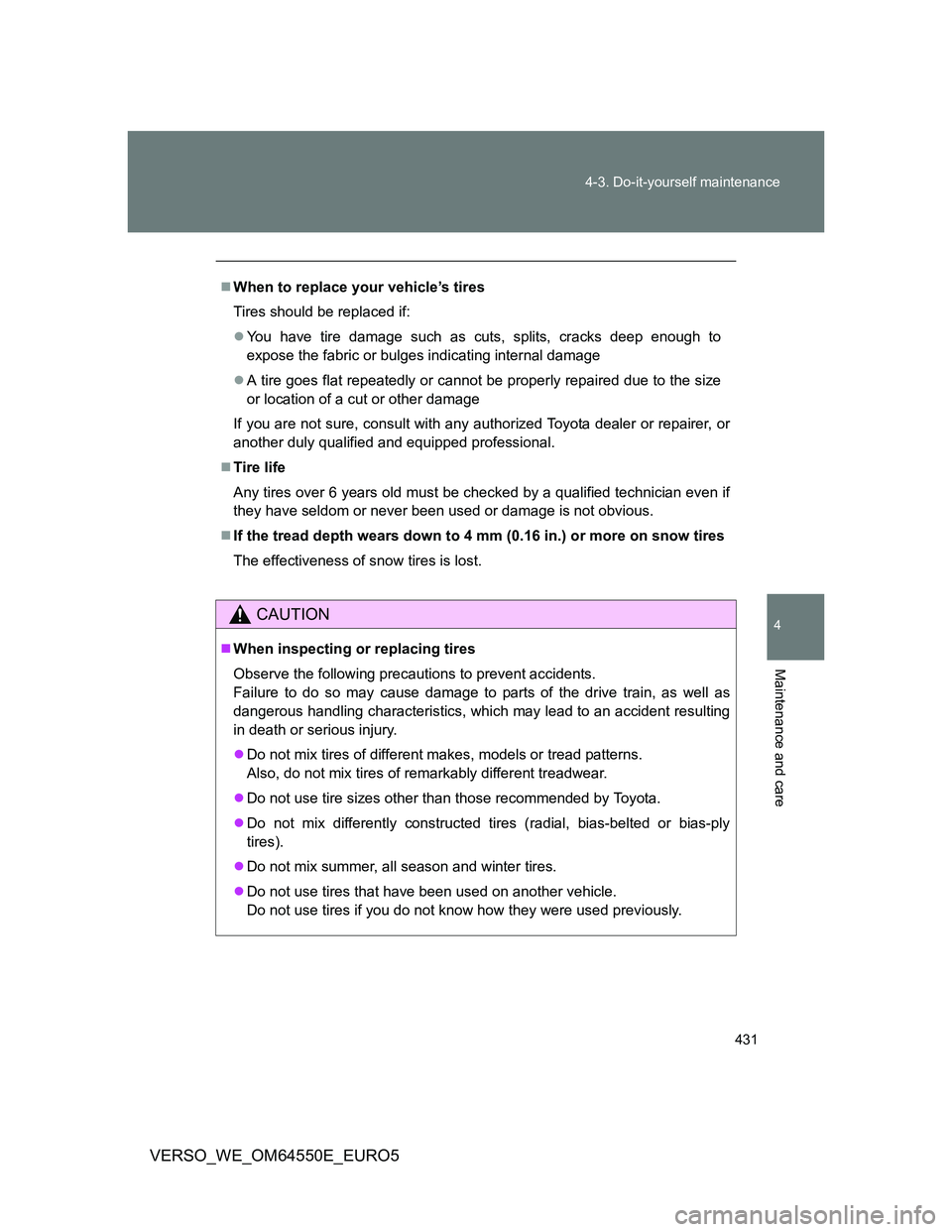
431 4-3. Do-it-yourself maintenance
4
Maintenance and care
VERSO_WE_OM64550E_EURO5
When to replace your vehicle’s tires
Tires should be replaced if:
You have tire damage such as cuts, splits, cracks deep enough to
expose the fabric or bulges indicating internal damage
A tire goes flat repeatedly or cannot be properly repaired due to the size
or location of a cut or other damage
If you are not sure, consult with any authorized Toyota dealer or repairer, or
another duly qualified and equipped professional.
Tire life
Any tires over 6 years old must be checked by a qualified technician even if
they have seldom or never been used or damage is not obvious.
If the tread depth wears down to 4 mm (0.16 in.) or more on snow tires
The effectiveness of snow tires is lost.
CAUTION
When inspecting or replacing tires
Observe the following precautions to prevent accidents.
Failure to do so may cause damage to parts of the drive train, as well as
dangerous handling characteristics, which may lead to an accident resulting
in death or serious injury.
Do not mix tires of different makes, models or tread patterns.
Also, do not mix tires of remarkably different treadwear.
Do not use tire sizes other than those recommended by Toyota.
Do not mix differently constructed tires (radial, bias-belted or bias-ply
tires).
Do not mix summer, all season and winter tires.
Do not use tires that have been used on another vehicle.
Do not use tires if you do not know how they were used previously.
Page 432 of 616
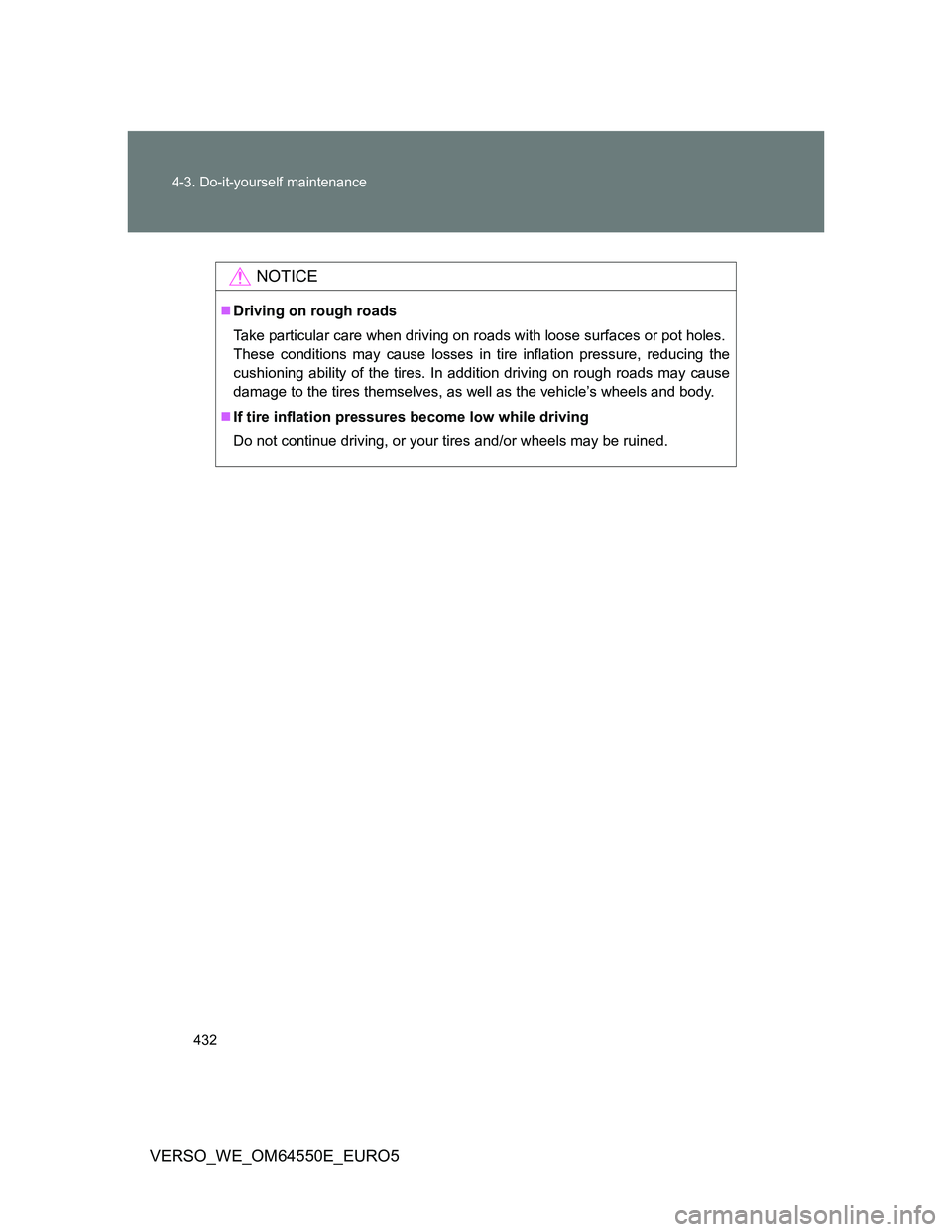
432 4-3. Do-it-yourself maintenance
VERSO_WE_OM64550E_EURO5
NOTICE
Driving on rough roads
Take particular care when driving on roads with loose surfaces or pot holes.
These conditions may cause losses in tire inflation pressure, reducing the
cushioning ability of the tires. In addition driving on rough roads may cause
damage to the tires themselves, as well as the vehicle’s wheels and body.
If tire inflation pressures become low while driving
Do not continue driving, or your tires and/or wheels may be ruined.
Page 433 of 616
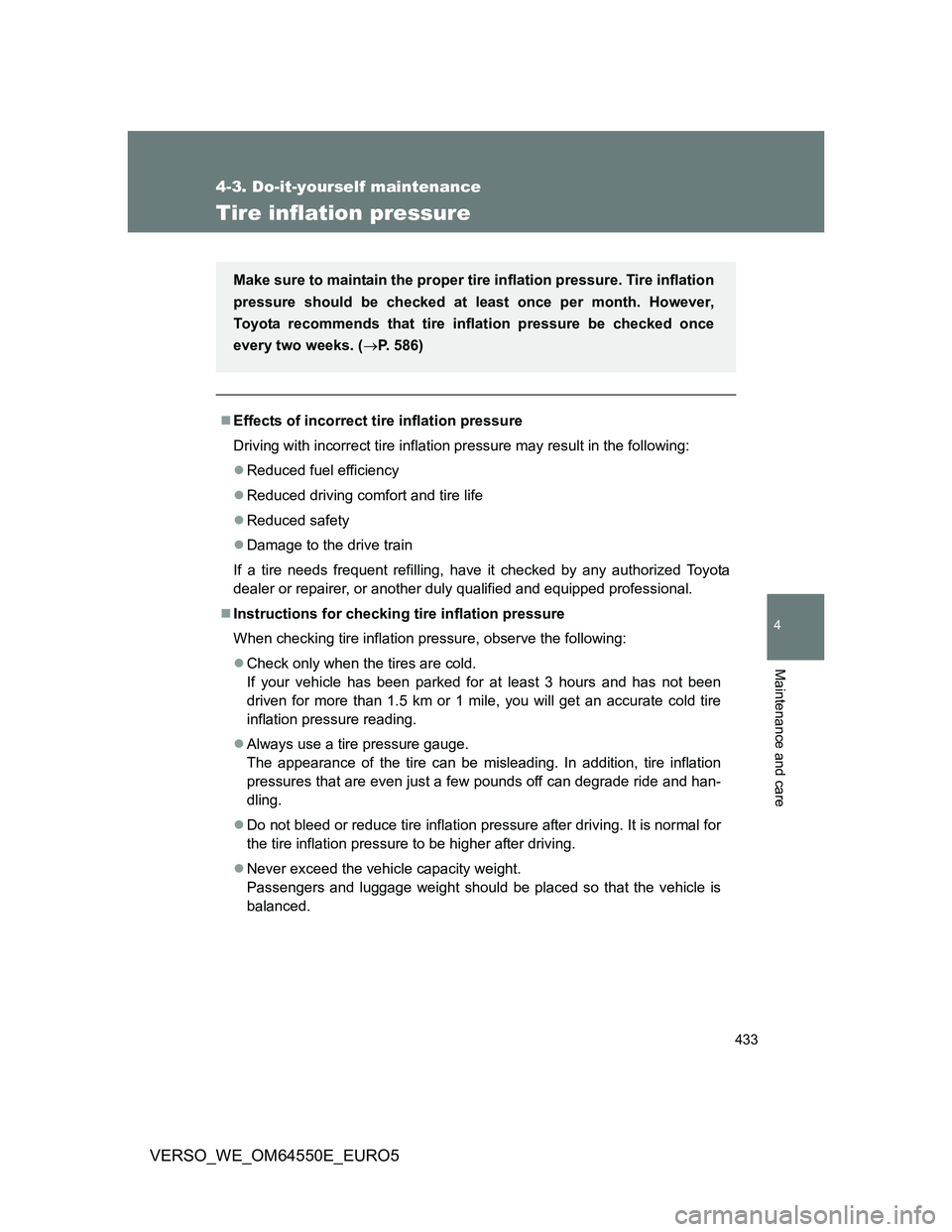
433
4-3. Do-it-yourself maintenance
4
Maintenance and care
VERSO_WE_OM64550E_EURO5
Tire inflation pressure
Effects of incorrect tire inflation pressure
Driving with incorrect tire inflation pressure may result in the following:
Reduced fuel efficiency
Reduced driving comfort and tire life
Reduced safety
Damage to the drive train
If a tire needs frequent refilling, have it checked by any authorized Toyota
dealer or repairer, or another duly qualified and equipped professional.
Instructions for checking tire inflation pressure
When checking tire inflation pressure, observe the following:
Check only when the tires are cold.
If your vehicle has been parked for at least 3 hours and has not been
driven for more than 1.5 km or 1 mile, you will get an accurate cold tire
inflation pressure reading.
Always use a tire pressure gauge.
The appearance of the tire can be misleading. In addition, tire inflation
pressures that are even just a few pounds off can degrade ride and han-
dling.
Do not bleed or reduce tire inflation pressure after driving. It is normal for
the tire inflation pressure to be higher after driving.
Never exceed the vehicle capacity weight.
Passengers and luggage weight should be placed so that the vehicle is
balanced.
Make sure to maintain the proper tire inflation pressure. Tire inflation
pressure should be checked at least once per month. However,
Toyota recommends that tire inflation pressure be checked once
every two weeks. (P. 586)
Page 434 of 616
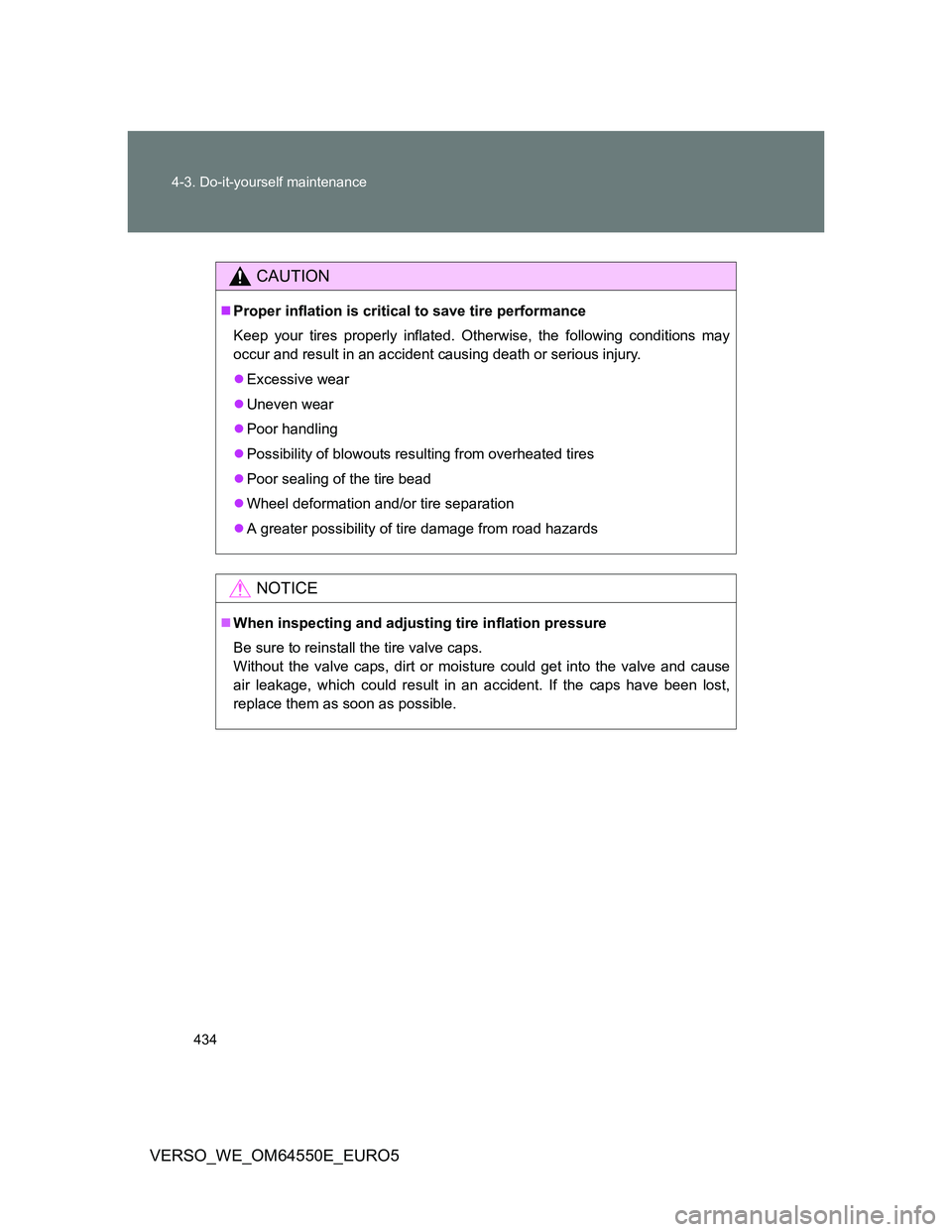
434 4-3. Do-it-yourself maintenance
VERSO_WE_OM64550E_EURO5
CAUTION
Proper inflation is critical to save tire performance
Keep your tires properly inflated. Otherwise, the following conditions may
occur and result in an accident causing death or serious injury.
Excessive wear
Uneven wear
Poor handling
Possibility of blowouts resulting from overheated tires
Poor sealing of the tire bead
Wheel deformation and/or tire separation
A greater possibility of tire damage from road hazards
NOTICE
When inspecting and adjusting tire inflation pressure
Be sure to reinstall the tire valve caps.
Without the valve caps, dirt or moisture could get into the valve and cause
air leakage, which could result in an accident. If the caps have been lost,
replace them as soon as possible.
Page 475 of 616
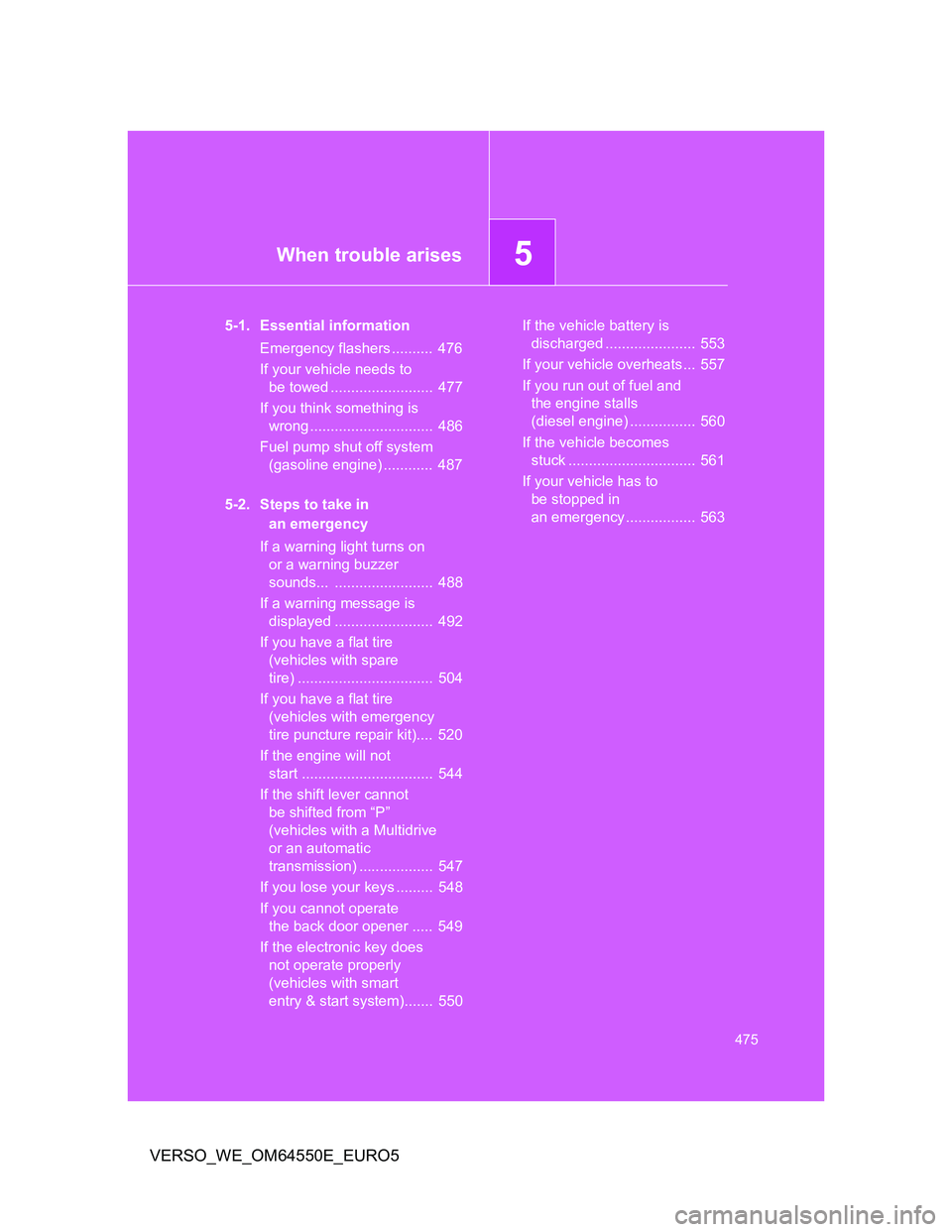
5When trouble arises
475
VERSO_WE_OM64550E_EURO5
5-1. Essential information
Emergency flashers .......... 476
If your vehicle needs to
be towed ......................... 477
If you think something is
wrong .............................. 486
Fuel pump shut off system
(gasoline engine) ............ 487
5-2. Steps to take in
an emergency
If a warning light turns on
or a warning buzzer
sounds... ........................ 488
If a warning message is
displayed ........................ 492
If you have a flat tire
(vehicles with spare
tire) ................................. 504
If you have a flat tire
(vehicles with emergency
tire puncture repair kit).... 520
If the engine will not
start ................................ 544
If the shift lever cannot
be shifted from “P”
(vehicles with a Multidrive
or an automatic
transmission) .................. 547
If you lose your keys ......... 548
If you cannot operate
the back door opener ..... 549
If the electronic key does
not operate properly
(vehicles with smart
entry & start system)....... 550If the vehicle battery is
discharged ...................... 553
If your vehicle overheats ... 557
If you run out of fuel and
the engine stalls
(diesel engine) ................ 560
If the vehicle becomes
stuck ............................... 561
If your vehicle has to
be stopped in
an emergency ................. 563
Page 486 of 616

486
5-1. Essential information
VERSO_WE_OM64550E_EURO5
If you think something is wrong
If you notice any of the following symptoms, your vehicle probably
needs adjustment or repair. Contact any authorized Toyota dealer or
repairer, or another duly qualified and equipped professional, as
soon as possible.
Visible symptoms
Fluid leaks under the vehicle
(Water dripping from the air conditioning after use is normal.)
Flat-looking tires or uneven tire wear
High engine coolant temperature warning light flashes or
comes on
Low engine coolant temperature indicator comes on or does
not come on continuously
Audible symptoms
Changes in exhaust sound
Excessive tire squeal when cornering
Strange noises related to the suspension system
Pinging or other noises related to the engine
Operational symptoms
Engine misfire, stumbling or running rough
Appreciable loss of power
Vehicle pulls heavily to one side when braking
Vehicle pulls heavily to one side when driving on a level road
Loss of brake effectiveness, spongy feeling, pedal almost
touches the floor
Page 504 of 616
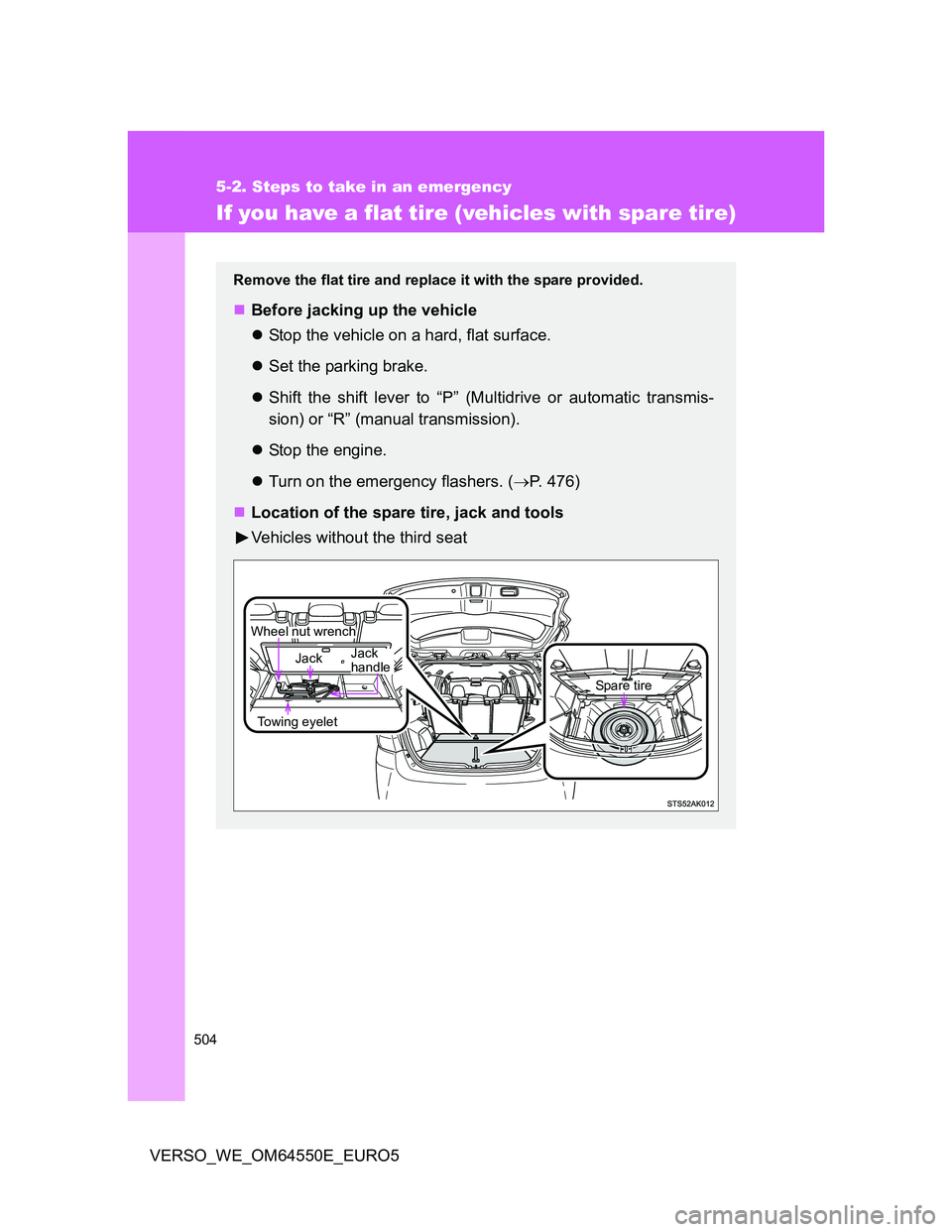
504
5-2. Steps to take in an emergency
VERSO_WE_OM64550E_EURO5
If you have a flat tire (vehicles with spare tire)
Remove the flat tire and replace it with the spare provided.
Before jacking up the vehicle
Stop the vehicle on a hard, flat surface.
Set the parking brake.
Shift the shift lever to “P” (Multidrive or automatic transmis-
sion) or “R” (manual transmission).
Stop the engine.
Turn on the emergency flashers. (P. 476)
Location of the spare tire, jack and tools
Vehicles without the third seat
Spare tire
Jack
handleJack
Wheel nut wrench
Towing eyelet
Page 511 of 616
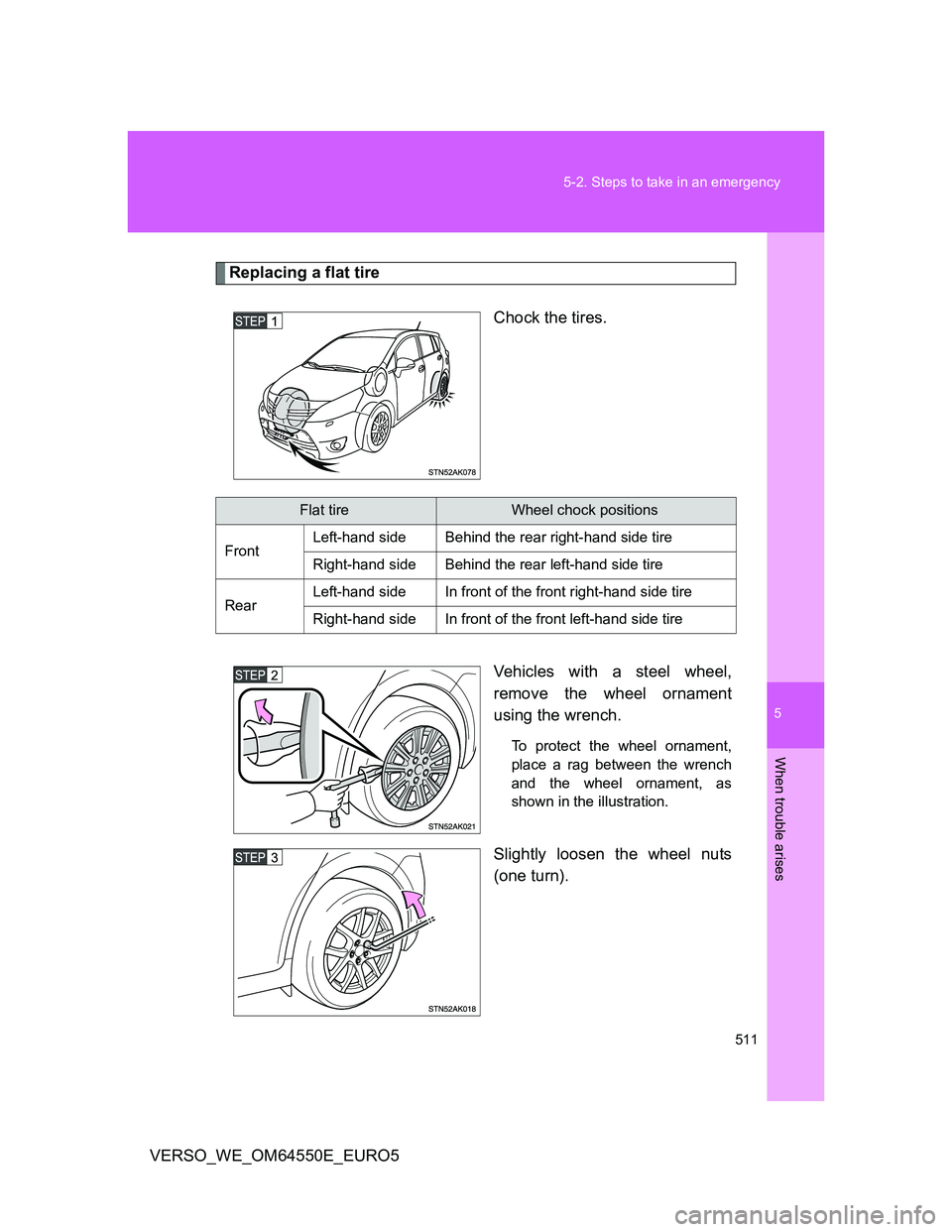
5
511 5-2. Steps to take in an emergency
When trouble arises
VERSO_WE_OM64550E_EURO5
Replacing a flat tire
Chock the tires.
Vehicles with a steel wheel,
remove the wheel ornament
using the wrench.
To protect the wheel ornament,
place a rag between the wrench
and the wheel ornament, as
shown in the illustration.
Slightly loosen the wheel nuts
(one turn).
Flat tireWheel chock positions
FrontLeft-hand side Behind the rear right-hand side tire
Right-hand side Behind the rear left-hand side tire
RearLeft-hand side In front of the front right-hand side tire
Right-hand side In front of the front left-hand side tire
Page 514 of 616
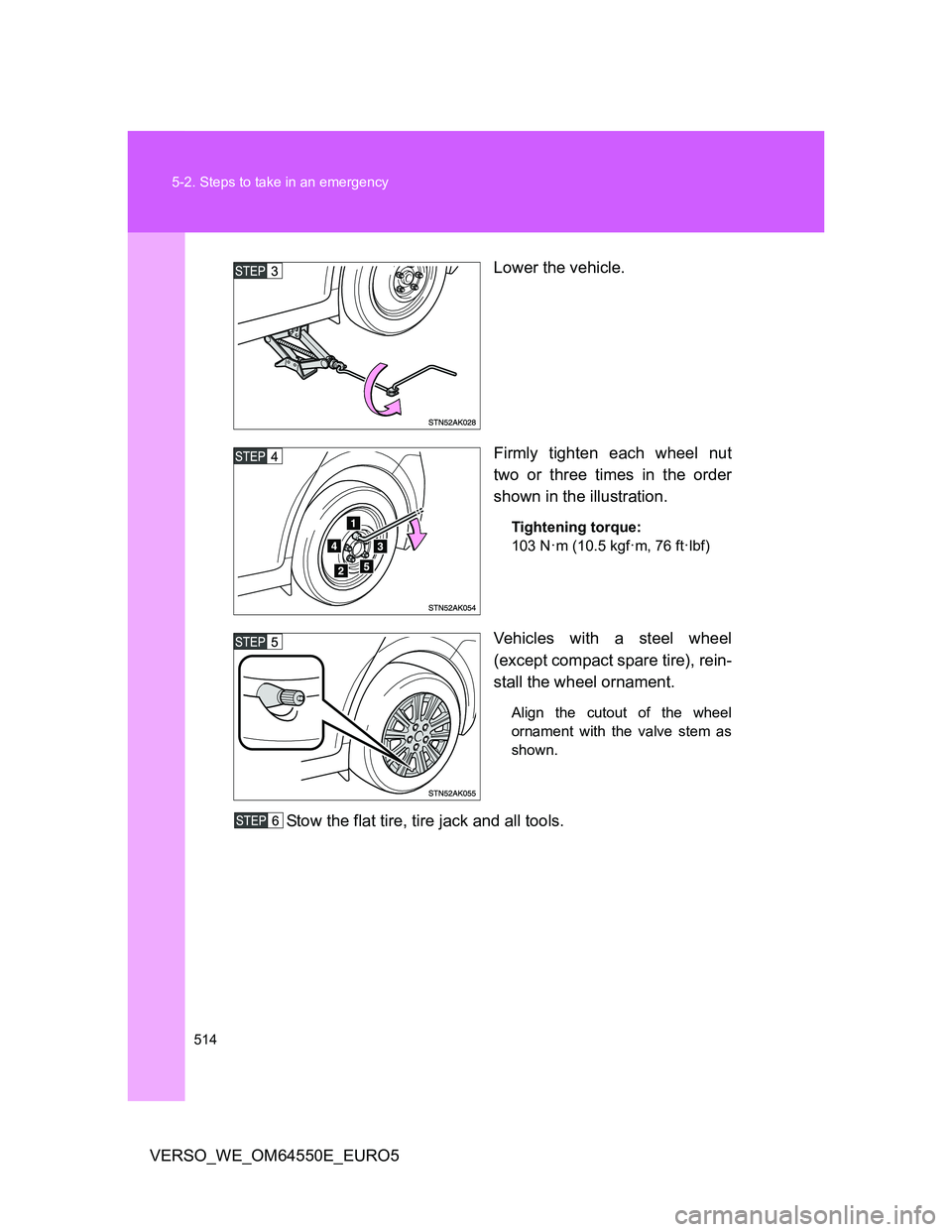
514 5-2. Steps to take in an emergency
VERSO_WE_OM64550E_EURO5Lower the vehicle.
Firmly tighten each wheel nut
two or three times in the order
shown in the illustration.
Tightening torque:
103 N
·m (10.5 kgf·m, 76 ft·lbf)
Vehicles with a steel wheel
(except compact spare tire), rein-
stall the wheel ornament.
Align the cutout of the wheel
ornament with the valve stem as
shown.
Stow the flat tire, tire jack and all tools.